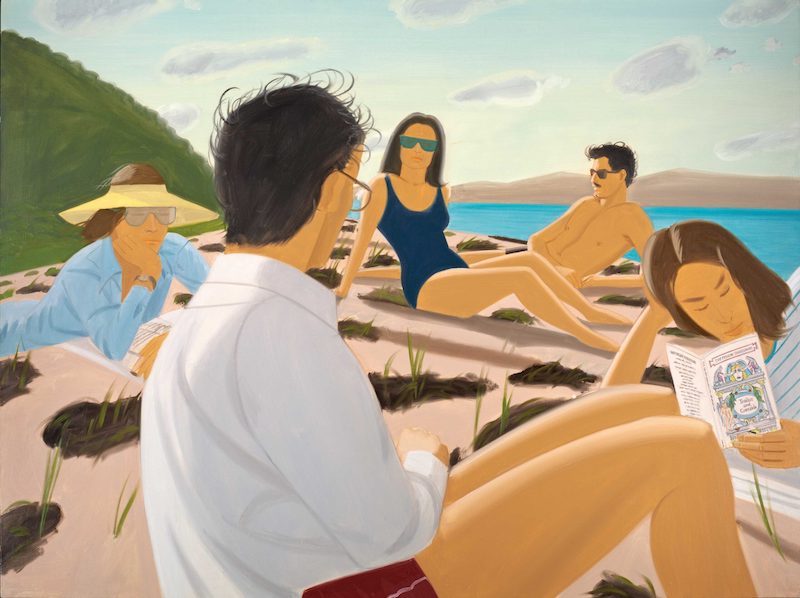At the Guggenheim, ‘Gathering’ Brings Together Alex Katz’s Life and Art
A retrospective for a nonagenarian artist who shows no signs of slowing down.

The artist Alex Katz, now in his 95th year, has lived a long life, and “Alex Katz: Gathering,” at the Guggenheim, can feel like a long haul. It takes up the entirety of the museum’s corkscrew premises, designed by architect Frank Lloyd Wright, and features work that ranges from hazy abstraction to bright representation, and then back again.
Citizens of the zeitgeist likely know his “Sharon and Vivien,” which adorns the cover of the Irish author Sally Rooney’s best-selling “Conversations with Friends.” It is Katz at his best; jazzy, witty, and precise. Mr. Katz is both stylish and attuned to style in his subjects. They always look good. If some painters plumb depths, Mr. Katz homes in on surfaces, rendering them smooth and close up.
More than six decades ago, Mr. Katz rhapsodized that “eternity exists in minutes of absolute awareness.” His work aspires to hold what he calls “quick things passing” by freezing them in bright relief. The Guggenheim explains that he “forged a mode of figurative painting that fused the energy and distillation of Abstract Expressionist canvases with the American vernaculars of the magazine, billboard, and movie screen.”
“Gathering,” curated by Katherine Brinson, who heads contemporary art at the Guggenheim, runs through the end of February. It is unlikely that every piece will speak to every visitor, but also unlikely that none of the more than 150 on display will do so. That is because Mr. Katz is so protean, pitched between Pop and Photo-Realism, equally interested in the coast of Maine and his New York bohemian set of poets and painters.
Mr. Katz was born in Brooklyn and grew up in Queens. His father, a Jewish emigre from the Soviet Union, lost his factory to the dictatorship of the proletariat. He studied at the Cooper Union and Skowhegan School of Painting and Sculpture in Maine, and both his life and his art have for decades been defined by the Empire and Pine Tree states. He splits his time between SoHo and Lincolnville, and is an artist captivated by presence and absence.
A lovely work from 1959, “4 PM,” shows his wife, Ada, sitting on a couch, her legs curled up, bathed in a yellow light. It manages to be both pensive and languorous, capturing something of the in-betweenness of the hour where afternoon slides into evening. “Ada Ada,” from the same year, is another one of the hundreds of thousands of depictions Mr. Katz has made of his wife. He often doubles her on the canvas, as if to suggest that his love multiplies.
“Round Hill,” from 1977, is a beach bum’s delight. Executed with Mr. Katz’s signature foreshortened perspective that puts the viewer nearly inside the frame, the painting depicts a group of friends lounging on the shore, angular and legs akimbo in the particular geometry of a sandy afternoon. One woman is reading William Shakespeare’s “Troilus and Cressida,” the pages likely curled at the edges from sea breeze and salt water.

Mr. Katz explores a different climate in “Blue Umbrella 2,” which features Ada in closeup and under the eponymous umbrella. Her glamor is framed rather than undermined by lashing rain, with the wet drops’ trajectory seemingly altered by her stylish scarf and arresting face. The painting distills the affinity of Mr. Katz’s work for the aesthetics of billboard and film, a visual intelligence that suggests the cinematic as much as the painterly.
“Paul Taylor Dance Company,” from 1963-64, is a study in stillness and kinetics, posture and pose. Mr. Katz collaborated with the choreographer for more than a half century, and this painting demonstrates an eye for both the dancer and the dance. “The Black Dress,” from 1960, features Ada in six poses, a party peopled by one person. “Double Portrait of Robert Rauschenberg,” from the year before, casts the artist as subject.
“West 2,” from 1998, forgoes both persons and pigment for a fathomless urban darkness pricked only by rectangles of light emanating from windows. It is a meditation on opacity and translucency, the palette of New York City at night. It is disorienting in the way nighttime can be and owes a debt to Edward Hopper’s painterly voyeurism at windows, and through them. “Lake Time,” from 40 years earlier, is an ode to the daytime.
The show features a generous sampling of Mr. Katz’s recent work, which indicates a turn toward gesture and the galactic. Like Henri Matisse and Willem de Kooning before him, age has precipitated a focus on the elemental, a kind of distillation of shapes and strokes. “Yellow Tree 1,” from 2020, is a solar riot, as if it was painted from within an exploding sun. Blue gobs of paint zoom by, heralding fresh tidings for an old man still making it new.

